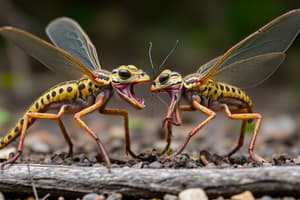Podcast
Questions and Answers
Which of the following correctly represents the hierarchical classification of Homo sapiens?
Which of the following correctly represents the hierarchical classification of Homo sapiens?
- Genus > Family > Phylum > Class > Order
- Kingdom > Phylum > Class > Order > Family (correct)
- Species > Order > Family > Class > Phylum
- Phylum > Class > Order > Family > Genus
What is the primary purpose of taxonomy in biology?
What is the primary purpose of taxonomy in biology?
- To facilitate the identification, nomenclature, and classification of organisms (correct)
- To create new species by hybridization
- To develop genetic modification techniques
- To produce medicinal compounds from organisms
Which taxonomic level is represented by the term 'Muscidae' in the classification of the housefly?
Which taxonomic level is represented by the term 'Muscidae' in the classification of the housefly?
- Order
- Class
- Phylum
- Family (correct)
Which organism is classified under the class 'Monocotyledonae'?
Which organism is classified under the class 'Monocotyledonae'?
In the binomial nomenclature system, how many words comprise the scientific name of an organism?
In the binomial nomenclature system, how many words comprise the scientific name of an organism?
What classification is used for the order to which the mango belongs?
What classification is used for the order to which the mango belongs?
Which of the following organisms is classified in the phylum Arthropoda?
Which of the following organisms is classified in the phylum Arthropoda?
Which level of taxonomic classification comes after Phylum?
Which level of taxonomic classification comes after Phylum?
What is the family name for the organism commonly known as man?
What is the family name for the organism commonly known as man?
Which of the following correctly classifies the order of wheat?
Which of the following correctly classifies the order of wheat?
Flashcards are hidden until you start studying
Study Notes
Ecological Conflict and Cooperation
- Ecological interactions among population members and communities prompt reflection on the essence and purpose of life.
- Two core questions arise: the technical definition of living versus non-living, and the philosophical inquiry into life’s purpose.
Diversity in the Living World
- A vast variety of living organisms can be observed in various environments (plants, insects, birds, etc.).
- Microscopic organisms exist all around, highlighting the unseen diversity of life.
- Exploration of different habitats (e.g., dense forests) reveals a greater variety of species.
Biodiversity
- The known number of species ranges from 1.7 to 1.8 million, illustrating the concept of biodiversity.
- New organisms are continuously identified as exploration of both new and familiar areas continues.
Biology and Early Perception of Life
- Biology is defined as the study of life forms and living processes.
- Early humans distinguished between living organisms and inanimate matter, often assigning sacred reverence to both.
- The systematic description of organisms occurred later, leading to significant biological knowledge development.
Taxonomy
- The classification of organisms (taxonomy) arose from the need for organized identification and nomenclature.
- Recognition of similarities among organisms has led to cultural movements focused on biodiversity conservation.
- Taxonomy encompasses identification, naming, and classification, essential for understanding bio-resources and diversity.
Taxonomic Categories
- Organisms are classified into hierarchical taxonomic categories including Kingdom, Phylum, Class, Order, Family, Genus, and species.
- Examples of taxonomic categorization:
- Man (Homo sapiens): Hominidae, Primata, Mammalia, Chordata
- Housefly (Musca domestica): Muscidae, Diptera, Insecta, Arthropoda
- Mango (Mangifera indica): Anacardiaceae, Sapindales, Dicotyledonae, Angiospermae
- Wheat (Triticum aestivum): Poaceae, Poales, Monocotyledonae, Angiospermae
Summary
- The living world exhibits immense diversity, with many species identified, yet many remain undiscovered.
- The characteristics of living organisms prompt biologists to establish rules for identification and classification.
- Taxonomic knowledge benefits agriculture, forestry, industry, and conservation efforts.
- The binomial nomenclature system provides a universal framework for naming organisms based on distinct characteristics.
Studying That Suits You
Use AI to generate personalized quizzes and flashcards to suit your learning preferences.




